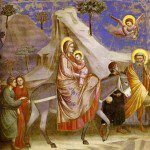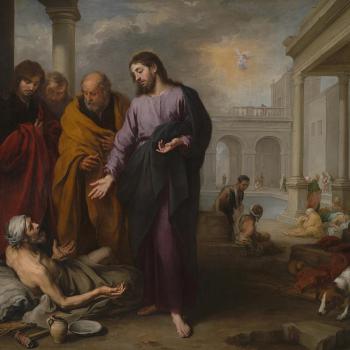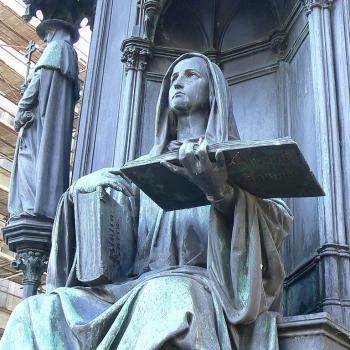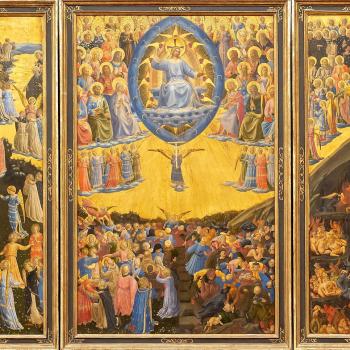![Ascension of Jesus By Andrej Rublëv and Daniil [Public domain], via Wikimedia Commons](https://wp-media.patheos.com/blogs/sites/637/2016/05/Ascension_from_Vasilyevskiy_chin_15th_c._GTG-210x300.jpg)
Heaven has come to earth so that the earth can be taken to heaven. The eschaton has become immanent so that creation can be taken to the eschaton and find its proper place in eternity. The Son of God became man so that humanity, and all of creation, can become deified and partake of the divine nature, becoming by grace what the Son of God is by nature. The ascension is the finalization of the work of Christ, where he enters into eternity – outside of time and space — so that he can be with us all to the end of time, in his new, glorified presence. The ascension is itself a demonstration of Jesus as the eschaton. This is why Jesus told St Mary Magdalene not to grasp after, not to try to seize him, when he had yet to ascend, because his work was only half-done (cf. Jn. 20:17).[1] As we cannot comprehend God, so we cannot seize hold of the resurrected Christ – he comes to us and gives himself in his glory to us, a glory which we can indeed touch, but one which we cannot seize. As God comprehends us, so the resurrected Christ surrounds us with his glory, seizing us in his grasp, not him in ours. He takes those who have willingly given themselves over to him to the right hand of the Father to receive eternal glory with him.
For this reason we are to look to the glory of eternity, to find our peace there, no matter what happens around us on earth. As St. Caesarius of Arles indicated, we should cast aside all those things which would hold us down, all our sin which seeks to bind us to the chaos which destroys being, so that we can then find our place in heaven:
Our Savior, dearly beloved, has ascended into heaven; therefore let us not be disturbed on earth. Let our spirit be there, and peace will be here. Meanwhile let us ascend with Christ in heart, and when His promised day comes, we shall also follow in body. Nevertheless, we ought to know that pride or avarice or dissipation did not ascend with Christ. And for this reason, if we desire to ascend and follow the physician, let us strive here to lay aside our vices and sins. [2]
The glory of heaven cannot be had so long as our heart is of the things of the earth, that is, we cannot enter into eternity with a heart for transitory things, treating them in their transitory nature as if they were worthy of eternal attachment. This is not to say we cannot see and appreciate the good of the earth and what is found in time – that is beyond question; its good is found in its proper eternal modality, as it is lifted up by Christ, showing its true and proper face in the eschaton. The problem is being attached to its external, tainted image found in its temporal form, holding on to such impurity as its face instead of as a mask which must be removed for its true form and presence to be known. It must be cleansed – its impurities removed; this is possible because of Jesus’s descent through hades, where he is able to take all forms of being and put them at their proper place for them, disengaging lower forms of being which are corrupting us and restoring them to their rightful place on the chain of being. That is, he who is before all things, he who created all things, is able to reestablish all things and hold them together (cf. Col. 1:17) as he places them before God the Father as a gift of love. His ascension to the “right hand of the Father” is the realization of this – the Apostles and disciples saw the beginning of the end as they saw Jesus ascend into the heavens before his exit from temporality and entrance into eternity. The eschaton is already and not yet, the Apostles saw the end of the old age (the resurrection of Christ) and the beginning of the end (the ascension) as indicated by St John Chrysostom:
Inasmuch, however, as the sight of their eyes even here was not all-sufficient; for in the Resurrection they saw the end, but not the beginning, and in the Ascension they saw the beginning, but not the end: because in the former it had been superfluous to have seen the beginning, the Lord Himself Who spoke these things being present, and the sepulchre showing clearly that He is not there; but in the latter, they needed to be informed of the sequel by word of others: inasmuch then as their eyes do not suffice to show them the height above, nor to inform them whether He is actually gone up into heaven, or only seemingly into heaven, see then what follows. That it was Jesus Himself they knew from the fact that He had been conversing with them (for had they seen only from a distance, they could not have recognized Him by sight), but that He is taken up into Heaven the Angels themselves inform them.[3]
Christ ascended to the Father, and sits at the Father’s right hand. Earth is taken up to heaven and participates in the glory of God. We must not think of heaven as a literal space, of Jesus’s’ sitting as literal sitting, and the right hand of the Father as a literal hand – they are all poetic images, metaphors which point to a truth which cannot be contained in words. Thus, St. Augustine explained:
“He ascended into heaven:” believe. “He sits at the right hand of the Father:” believe. By sitting, understand dwelling: as [in Latin] we say of any person, “In that country he dwelt (sedit) three years.” The Scripture also has that expression, that such an one dwelt (sedisse) in a city for such a time. Not meaning that he sat and never rose up? On this account the dwellings of men are called seats (sedes). Where people are seated (in this sense), are they always sitting? Is there no rising, no walking, no lying down? And yet they are called seats (sedes). In this way, then, believe an inhabiting of Christ on the right hand of God the Father: He is there. And let not your heart say to you, What is He doing? Do not want to seek what is not permitted to find: He is there; it suffices you. He is blessed, and from blessedness which is called the right hand of the Father, of very blessedness the name is, right hand of the Father. For if we shall take it carnally, then because He sits on the right hand of the Father, the Father will be on His left hand. Is it consistent with piety so to put Them together, the Son on the right, the Father on the left? There it is all right-hand, because no misery is there.[4]
Jesus by his ascent into heaven has gone beyond time and space into eternity. While his body is truly his and is with him in his eternal life, what it is like is beyond our comprehension as we think of bodies only within the domain of space and time. And as for what he is doing in this eternity, we know only in part, based upon our experience of the presence of the resurrected and glorified Christ in our lives, the sacramental presence which we experience in many and diverse ways, but especially in and through our communion with him in the eucharist.[5] He is active in the world as the world receives his new presence, the presence of the eschaton which draws all things to himself. The Holy Spirit which now flows from him, helping us realize his sacramental presence and finding the grace from it which will render us capable of eternal glory with him. This is why he said he must go (ascend to the Father) in order to share the gift of the Holy Spirit to the world. It is by Christ’s ascension, his entrance into heaven, into eternity, that he has taken earth into heaven. Now the Spirit is free to render its gifts to the world the gifts it gives to those in the kingdom of heaven, for earth is now raised in heaven and finds itself in the kingdom of God.
[1] St. Thomas was allowed to touch him, because Thomas was not trying to grasp him, which is why it was fine for him to touch the resurrected Christ while Mary was not free to hold him down.
[2] St. Caesarius of Arles, “On the Lord’s Ascension” in Sermons. Volume 3. trans. Sister Mary Magdeleine Mueller, O.S.F. (Washington, DC: Catholic University of America Press, 1973), 93. His sermon adapts and borrows heavily from Augustine’s Sermon 261.
[3] St. John Chrysostom, Homilies on the Acts of the Apostles in NPNF1I(11): 13.
[4] St. Augustine, “On the Creed” in NPNF1(3): 373.
[5] Thus, St. Leo the Great:
In order, therefore, dearly-beloved, that we may be capable of this blessedness, when all things were fulfilled which concerned the Gospel preaching and the mysteries of the New Testament, our Lord Jesus Christ, on the fortieth day after the Resurrection in the presence of the disciples, was raised into heaven, and terminated His presence with us in the body, to abide on the Father’s right hand until the times Divinely fore-ordained for multiplying the sons of the Church are accomplished, and He comes to judge the living and the dead in the same flesh in which He ascended. And so that which till then was visible of our Redeemer was changed into a sacramental presence, and that faith might be more excellent and stronger, sight gave way to doctrine, the authority of which was to be accepted by believing hearts enlightened with rays from above.
St. Leo the Great, Sermon LXIV in NPNF2(12): 188.
Stay in touch! Like A Little Bit of Nothing on Facebook:
A Little Bit of Nothing













